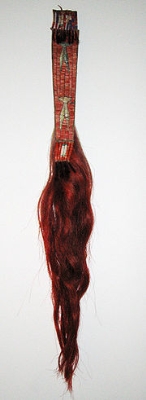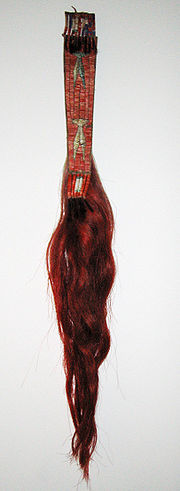
Hair drop
Encyclopedia

Great Lakes
The Great Lakes are a collection of freshwater lakes located in northeastern North America, on the Canada – United States border. Consisting of Lakes Superior, Michigan, Huron, Erie, and Ontario, they form the largest group of freshwater lakes on Earth by total surface, coming in second by volume...
and Plains tribes. It would be tied to the man's hair. The typical example consists of a quilled or beaded section on a strip of leather, which was later attached to an American buffalo
American buffalo
American buffalo is the colloquial name for the American bison.American Buffalo may refer to:*American Buffalo , a play by David Mamet*American Buffalo , a 1996 film of Mamet's play*American Buffalo , a United States coin...
tail. They could be over two feet long.
Early hair drops were decorated with porcupine quillwork.
As more Europeans arrived on Plains Indian lands in the later 19th century, glass beadwork became more common. Hair drops are frequently adorned with tin cones, silver, and feathers. The horse hair drop can be dyed for effect. One 1870 Cheyenne
Cheyenne
Cheyenne are a Native American people of the Great Plains, who are of the Algonquian language family. The Cheyenne Nation is composed of two united tribes, the Só'taeo'o and the Tsétsêhéstâhese .The Cheyenne are thought to have branched off other tribes of Algonquian stock inhabiting lands...
hair drop was adorned with peacock feathers.
In the late 19th century, hair drops incorporated German silver disks, known as hair plates. Hair plates were most popular from 1835 to 1870, but still made today for powwow
PowWow
PowWow is a wireless sensor network mote developed by the Cairn team of IRISA/INRIA. The platform is currently based on IEEE 802.15.4 standard radio transceiver and on an MSP430 microprocessor...
and ceremonial regalia. The men's hair drops are distinguished from women's hair plates, because the women wear theirs from belts at their waists.
Hair drops could have ceremonial importance. One Piegan Blackfeet hair drop was worn to bring prosperity and included horse hair to protect the owner's horse.
The term hair drop is also used for braids of human hair worn by Plains men, attached to adornment. For instance, hair drops have been attached to Kiowa
Kiowa
The Kiowa are a nation of American Indians and indigenous people of the Great Plains. They migrated from the northern plains to the southern plains in the late 17th century. In 1867, the Kiowa moved to a reservation in southwestern Oklahoma...
mescal bean bandoleer worn in Native American Church
Native American Church
Native American Church, a religious denomination which practices Peyotism or the Peyote religion, originated in the U.S. state of Oklahoma, and is the most widespread indigenous religion among Native Americans in the United States...
regalia.
Today 19th century hair drops are highly collectible and often sold by non-Native traders for thousands of dollars.

